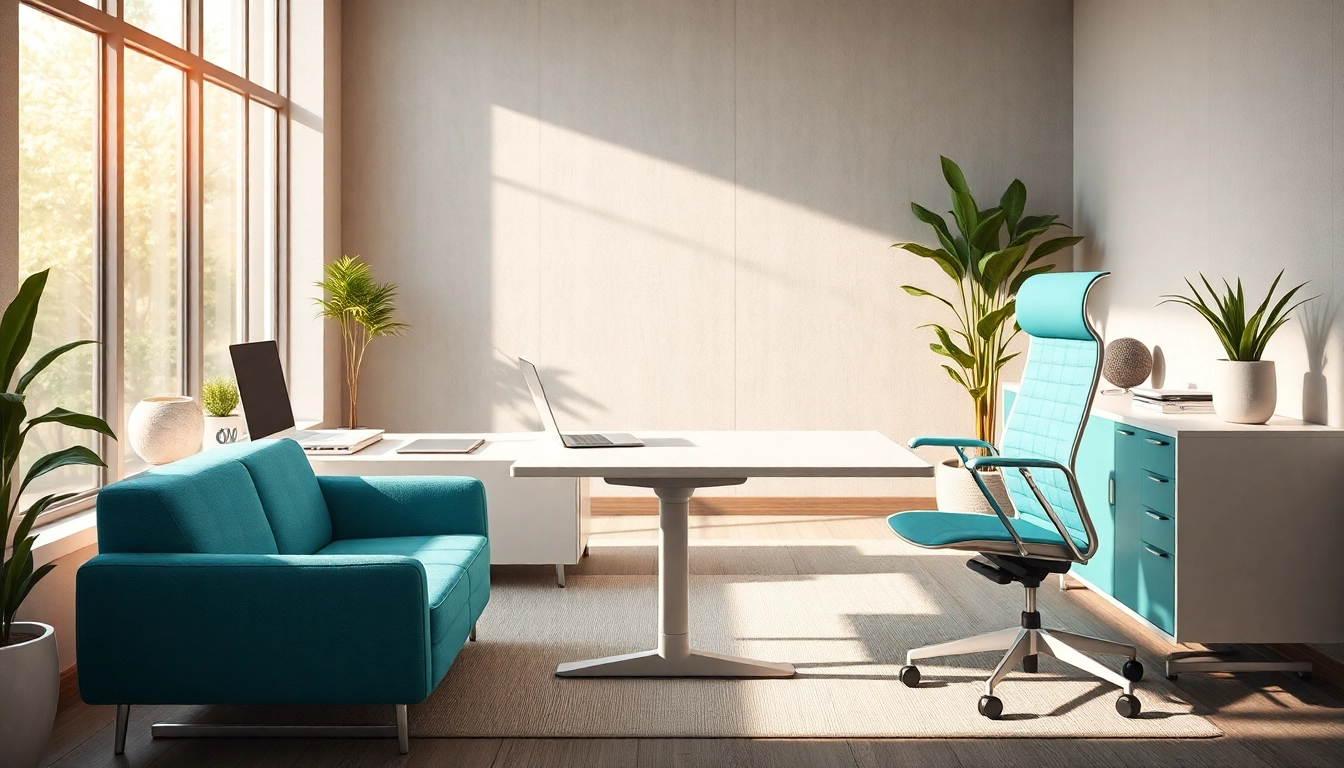Discover Ultimate Office Furniture: Enhancing Your Workspace Efficiency

1. Essential Office Furniture: Understanding Your Needs
In today’s fast-paced work environment, finding the right office furniture is crucial. Whether you’re setting up a new workspace or revamping an existing one, the furniture you choose can significantly impact both productivity and comfort. Understanding your specific needs plays a vital role in making informed decisions.
1.1 What to Consider When Selecting Office Furniture
When selecting office furniture, a variety of factors should be taken into consideration, including:
- Space Availability: Measure your office space before making any purchases. A congested area can lead to discomfort and decreased productivity!
- Functionality: Consider what tasks will be performed in the space daily. Your furniture should facilitate efficiency and collaboration.
- Style and Aesthetics: The visual impact of your office furniture can affect the overall atmosphere. Choose a style that aligns with your brand’s identity.
- Budget: Set a realistic budget that accommodates quality pieces without compromising on essential features.
- Versatility: Modular or adjustable furniture can adapt to different needs as your workspace changes.
1.2 Ergonomics in Office Furniture for Enhanced Comfort
Ergonomics is the science of designing a workplace that fits the user’s needs. Investing in ergonomic office furniture can lift morale and reduce the likelihood of injuries. Key ergonomic considerations include:
- Chairs: Opt for ergonomic chairs that provide lumbar support, adjustable height, and armrests.
- Desks: Sit-stand desks enable users to alternate between sitting and standing, which has been proven to improve comfort and productivity.
- Monitor Placement: Ensure that screens are at eye level to minimize strain on the neck.
1.3 How Office Furniture Impacts Work Productivity
The choices you make regarding office furniture have a direct impact on employee productivity. Well-designed office furniture can lead to:
- Improved Focus: A comfortable and inviting workspace can decrease distractions.
- Enhanced Collaboration: Open workstations encourage communication and teamwork.
- Positive Impressions: A well-furnished office sends a message of professionalism to clients and visitors.
2. Types of Office Furniture to Elevate Your Space
With a variety of office furniture types available, it’s critical to choose pieces that elevate your workspace and meet your specific functionality needs.
2.1 Desks and Workstations: Choosing the Right Fit
Desks serve as the command center of any office. Evaluate the types of tasks employees will perform when selecting desks. Consider options like:
- Executive Desks: Ideal for management, providing ample workspace and storage options.
- Height-Adjustable Desks: Encourages employees to manage comfort and health effectively.
- Collaborative Workstations: Designed for teamwork, facilitating communication and cooperation.
2.2 Chairs: The Importance of Support and Comfort
Chairs are one of the most important elements of office furniture as employees often spend long hours seated. Here’s a checklist for selecting the right office chairs:
- Adjustability: Ensure the chair offers height, armrest, and backrest adjustments to suit different body types.
- Material: Breathable and supportive materials will enhance comfort during extended use.
- Mobility: Choose chairs with wheels and swivel capabilities for easy movement and accessibility.
2.3 Storage Solutions: Organizing Your Office Furniture
An organized workplace is essential for productivity. Implementing efficient storage solutions can help in maintaining an orderly environment. Key storage options include:
- Filing Cabinets: Essential for keeping important documents organized and easily accessible.
- Shelving Units: Provides additional space for books, supplies, or decorative elements.
- Multi-Functional Furniture: Consider desks with built-in storage solutions to save space while keeping essentials at hand.
3. Modern Office Furniture Trends to Watch
The office furniture industry is ever-evolving, reflecting changes in technology, work culture, and consumer preferences. Here are some modern trends:
3.1 Sustainable Materials in Office Furniture Design
As environmental awareness grows, businesses are prioritizing sustainability in their furniture choices. Opting for recycled materials or sustainably sourced wood can significantly reduce environmental impact. Sustainable office furniture not only benefits the planet but can also enhance your brand’s image.
3.2 Smart Office Furniture: Integrating Technology
Smart office furniture incorporates technology into design, providing capabilities such as integrated charging ports and settings for digital devices. These features not only enhance convenience but also foster a tech-friendly work environment.
3.3 Customization Options for Office Furniture
Customization allows businesses to tailor office furniture to match their branding and functional needs. From color choices to specific dimensions, offering personalized options can create an inviting and cohesive workspace.
4. Creating a Cohesive Design with Office Furniture
A thoughtfully designed office reflects your company culture and enhances the work experience. Here’s how to create a cohesive look:
4.1 Color Schemes: How to Pick the Right Palette
Colors influence mood and productivity. Opt for a color palette that complements your brand while also providing a calming influence. Consider integrating bright accent colors to stimulate creativity.
4.2 Layout Strategies for Office Furniture Arrangement
Strategically arranging your office furniture affects both functionality and collaboration. Some layout strategies to consider include:
- Open Plan Layout: Fosters communication and teamwork.
- Dedicated Collaboration Areas: Encourage brainstorming and group meetings.
- Flexible Spaces: Allow employees to choose their work environment based on their current tasks.
4.3 Accessories to Complement Your Office Furniture
Accessories can enhance both functionality and aesthetics in your office space. Consider adding:
- Plants: Improve air quality and add a refreshing touch.
- Artwork: Personalizes the space and can serve as inspiration.
- Lighting: Utilize adjustable lighting fixtures to enhance mood and visibility.
5. Maintenance and Longevity of Office Furniture
Investing in quality office furniture is only part of the equation. Ensuring its longevity requires regular maintenance and care.
5.1 Cleaning and Caring for Different Office Furniture Materials
Understanding how to care for different materials is crucial for prolonging the life of your office furniture. Here are some tips:
- Wood: Use a soft cloth and a gentle cleanser; avoid abrasive materials.
- Fabric: Vacuum regularly and treat spots promptly to avoid stains.
- Metal: Wipe with a damp cloth and dry thoroughly to prevent rust.
5.2 When to Upgrade Your Office Furniture?
Recognizing when to upgrade your office furniture can save costs in the long run. Consider upgrading when:
- The furniture shows visible signs of wear, affecting comfort and functionality.
- Your business has evolved, needing different layouts or furniture types.
- Employee feedback indicates issues with current workspace arrangements.
5.3 The Economic Benefits of Investing in Quality Office Furniture
Quality office furniture is an investment that pays dividends in various ways:
- Enhanced Employee Satisfaction: Comfortable, functional furniture boosts morale and retention.
- Improved Efficiency: Properly designed workspaces enhance productivity, positively affecting overall performance.
- Reduction of Healthcare Costs: Ergonomically designed furniture minimizes workplace injuries, reducing sick days.






